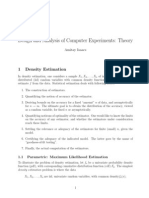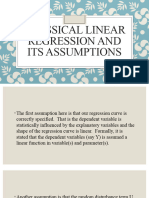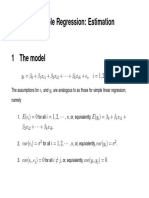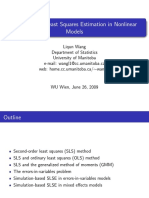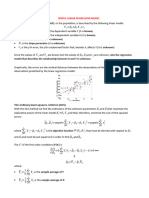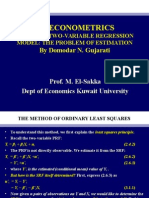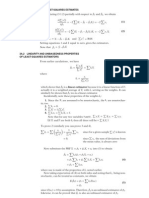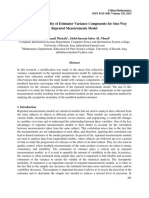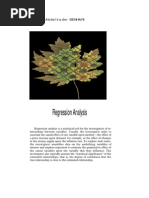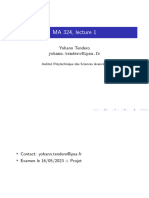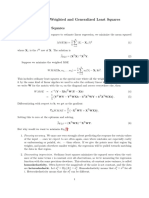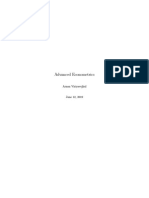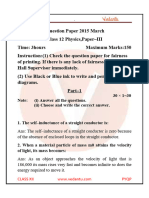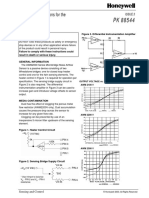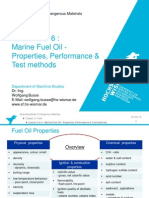ECONOMETRIC THEORY
MODULE – XVI
Lecture – 39
Measurement Error Models
Dr. Shalabh
Department of Mathematics and Statistics
Indian Institute of Technology Kanpur
� 2
Additional information for the consistent estimation of parameters
The parameters in the model can be consistently estimated only when some additional information about the model is
available.
From equations (i) and (ii), we have
µˆ = x
and so µ is clearly estimated. Further,
βˆ0= y − βˆ1 x
is estimated if β̂1 is uniquely determined. So we consider the estimation of β1 , σ , σ u and σ v only. Some additional
2 2 2
information is required for the unique determination of these parameters. We consider now various type of additional
information which are used for estimating the parameters uniquely.
1. σ v2 is known
Suppose σ v2 is known a priori. Now the remaining parameters can be estimated as follows:
mxx = σ 2 + σ v2 ⇒ σˆ 2 = mxx − σ v2
mxy
mxy= β1σ 2 ⇒ βˆ1=
mxx − σ v2
m yy = β1σ 2 + σ u2 ⇒ σˆ u2 = m yy − βˆ12σˆ 2
mxy2
= m yy − .
mxx − σ v2
Note that σ=
ˆ 2 mxx − σ v2 can be negative because σ v2 is known and mxx is based upon sample. So we assume that
σˆ 2 > 0 and redefine
mxy
= βˆ1 ; mxx > σ v2 .
mxx − σ 2
v
� 3
Similarly, σˆ u is also assumed to be positive under suitable condition. All the estimators βˆ1 , σˆ 2 and σˆ u2 are the
2
consistent estimators of β , σ and σ u , respectively. Note that β̂1 looks like as if the direct regression estimator of β1 has
2 2
been adjusted by σ v2 for its inconsistency. So it is termed as adjusted estimator also.
2. σ u2 is known
Suppose σ u2 is known a priori. Then using mxy = β1σ 2 , we can rewrite
m yy β12σ 2 + σ u2
=
= mxy β1 + σ u2
m yy − σ u2
⇒ β1
= ˆ ; myy > σ u2
mxy
mxy
σˆ 2 =
βˆ 1
σ=
ˆ2
vmxx − σˆ 2 .
The estimators βˆ1 , σˆ and σˆ v are the consistent estimators of β , σ and σ v , respectively. Note that
2 2 2 2
β̂1 looks like as if the
reverse regression estimator of β1 is adjusted by σ 2
u for its inconsistency. So it is termed as adjusted estimator also.
� 4
σ u2
3. λ = 2 is known
σv
Suppose the ratio of the measurement error variances is known, so let
σ u2
λ= 2
σv
is known.
Consider
m yy β12σ 2 + σ u2
=
= β1 mxy + λσ v2 (using (iv))
= β1 mxy + λ ( mxx − σ 2 ) (using (iii))
mxy
=β1 mxy + λ mxx − (using (iv))
β1
β12 mxy + λ ( β1mxx − mxy ) − β1myy= 0 ( β1 ≠ 0 )
β12 mxy + β ( λ mxx − myy ) − λ mxy =
0.
Solving this quadratic equation
(m − λ mxx ) ± (m − λ mxx ) + 4λ mxy2
2
βˆ1 =
yy yy
2mxy
U
= , say.
2mxy
� 5
Since mxy = β1σ 2 and
σˆ 2 ≥ 0
sxy
⇒ ≥0
βˆ1
2 sxy2
⇒ ≥0
U
⇒ since sxy2 ≥ 0, so U must be nonnegative.
This implies that the positive sign in U has to be considered and so
(m − λ mxx ) ± (m − λ mxx ) + 4λ mxy2
2
βˆ1 =
yy yy
2mxy
Other estimates are
m yy − 2 βˆ1mxy + βˆ12 sxx
σˆ =
2
λ + βˆ 2
v
1
mxy
σˆ 2 = .
βˆ 1
Note that the same estimator βˆ1 of β1 can be obtained by orthogonal regression. This amounts to transform xi by xi / σ u
and yi by yi / σ v and use the orthogonal regression estimation with transformed variables.
� 6
4. Reliability ratio is known
The reliability ratio associated with explanatory variable is defined as the ratio of variances of true and observed values of
explanatory variables, so
Var ( x ) σ2
K= = ; 0 ≤ Kx ≤ 1
Var ( x) σ 2 + σ v2
x
is the reliability ratio. Note that K x = 1 when σ v = 0 which means that there is no measurement error in the explanatory
2
variable and K x = 0 means σ 2 = 0 which means explanatory variable is fixed. Higher value of K x is obtained when σ v2
is small, i.e., the impact of measurement errors is small. The reliability ratio is a popular measure in psychometrics.
Let K x be known a priori. Then
m= xx σ 2 + σ v2
mxy = β1σ 2
mxy β1σ 2
⇒ =
mxx σ 2 + σ v2
= β1 K x
m
⇒ βˆ1 = xy
K x mxx
mxy
σ2 =
β1
⇒ σˆ 2 =
K x sxx
m=
xx σ 2 + σ v2
Note that βˆ1 = K x b ⇒ σˆ v2 =(1 − K x ) sxx .
−1
mxy
where b is the ordinary least squares estimator b = .
mxx
� 7
5. β 0 is known
Suppose β 0 is known a priori and E ( x) ≠ 0. Then
y β 0 + β1µ
=
y −β
⇒ βˆ1 = 0
µˆ
y − β0
=
x
m
σˆ 2 = xy
βˆ 1
σ=
ˆ2
um yy − βˆ1mxy
mxy
σ=
ˆ v2 mxx − .
βˆ1
6. Both σ u2 and σ v2 are known
This case leads to over-identification in the sense that the number of parameters to be estimated are smaller than the
number of structural relationships binding them. So no unique solutions are obtained in this case.
Note: In each of the cases 1-6, note that the form of the estimate depends on the type of available information which is
needed for the consistent estimator of the parameters. Such information can be available from various sources, e.g.,
long association of the experimenter with the experiment, similar type of studies conducted in the part, some extraneous
source etc.
� 8
Estimation of parameters in function form
In the functional form of the measurement error model, xi ' s are assumed to be fixed. This assumption is unrealistic in
the sense that when xi ' s are unobservable and unknown, it is difficult to know if they are fixed or not. This can not be
ensured even in repeated sampling that the same value is repeated. All that can be said in this case is that the information
in this case is conditional upon xi ' s. So assume that xi ' s are conditionally known. So the model is
y=
i β 0 + β1 xi
x=
i xi + vi
y=
i yi + ui .
Then
yi α + β xi σ u2 0
~ N , 2
.
xi xi 0 σ v
The likelihood function is
n n
2
∑( y − β − β x ) ∑ ( xi − xi )
n 2 n
2 i 0
1
1 i 2 1
L= exp − exp − .
=i 1 =i 1
2
u u
2
2πσ 2
v 2σ 2πσ 2σ v2
The log-likelihood is
n
∑( y − β 0 − β1 xi )
2
i
n n 1 n
2 ∑( i
L* = constant − ln σ u2 −
ln L = − ln σ v2 − x − xi ) .
i =1 2
2 2σ u2 2 2σ v i =1
�The normal equations are obtained by partially differentiating L* and equating to zero as 9
∂L * 1 n
(I ) =0 ⇒ 2 ∑ ( yi − β 0 − β1 xi ) =0
∂β 0 σ u i =1
∂L * 1 n
( II ) =0 ⇒ 2 ∑ ( yi − β 0 − β1 xi ) xi =0
∂β1 σ v i =1
∂L * n 1 n
= ⇒ − + ∑ ( − β − β ) = 0
2
( III ) 0 y x
∂σ u2 2σ u2 2σ u4 i =1
i 0 1 i
∂L * n 1 n
4 ∑( i
= 0⇒− 2 + x − xi ) = 0
2
( IV )
∂σ v
2
2σ v 2σ v i =1
∂L * β 1
(V ) = 0 ⇒ 2 ( yi − β 0 − β1 xi ) + 2 ( xi − xi ) =
0.
∂xi σu σv
Squaring and summing equation (V), we get
2 2
β 1
∑i σ 12 ( yi − β0 − β1 xi ) = ∑i − σ 2 ( xi − xi )
u v
β12 1
2 ∑( i 1 xi ) 4 ∑( i
y − β 0 − β= x − xi ) .
2 2
or
σu i σv i
Using the left hand side of equation (III) and right hand side of equation (IV), we get
nβ 2 n
=
σ u2 σ v2
σ
⇒ β =u .
σv
� 10
which is unacceptable because β can be negative also. In the present case, as σ u > 0 and σ v > 0, so β will always be
positive. Thus the maximum likelihood breaks down because of insufficient information in the model. Increasing the
σ u2
sample size n does not solve the purpose. If the restrictions like σ 2
known, σ 2
known or known are
σ v2
u v
incorporated, then the maximum likelihood estimation is similar to as in the case of structural form and the similar estimates
may be obtained. For example, if λ = σ u / σ v is known, then substitute it in the likelihood function and maximize it. The
2 2
same solution as in the case of structural form are obtained.
